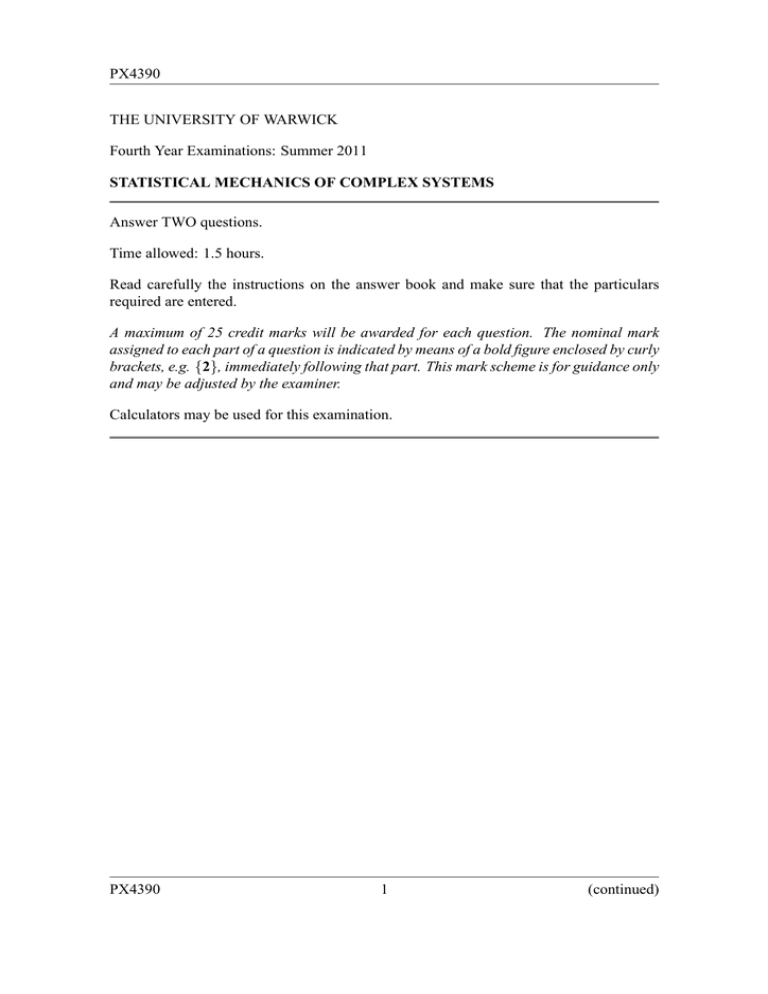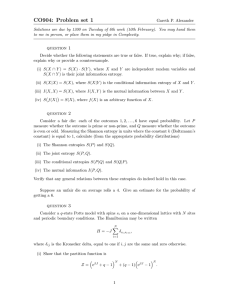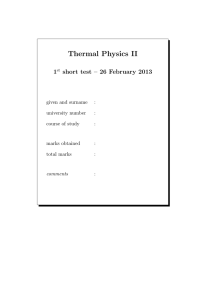PX4390 THE UNIVERSITY OF WARWICK Fourth Year Examinations: Summer 2011 Answer TWO questions.
advertisement

PX4390
THE UNIVERSITY OF WARWICK
Fourth Year Examinations: Summer 2011
STATISTICAL MECHANICS OF COMPLEX SYSTEMS
Answer TWO questions.
Time allowed: 1.5 hours.
Read carefully the instructions on the answer book and make sure that the particulars
required are entered.
A maximum of 25 credit marks will be awarded for each question. The nominal mark
assigned to each part of a question is indicated by means of a bold figure enclosed by curly
brackets, e.g. {2}, immediately following that part. This mark scheme is for guidance only
and may be adjusted by the examiner.
Calculators may be used for this examination.
PX4390
1
(continued)
PX4390
1.
Let X and Y denote two random variables, where X takes values x1 , x2 , . . . , and Y
takes values y1 , y2 , . . . . Use the following notation for the probabilities:
pij = P (X = xi , Y = yj )
(X)
= P (X = xi )
(Y )
= P (Y = yi )
pi
pi
(a) In terms of the above probabilities, express the joint information entropy of
X and Y , their conditional information entropies, and the mutual information
between X and Y .
{8}
(b) For two general random variables X and Y , what relation(s) hold between the
information entropies of X and Y , the joint information entropy, the conditional
information entropies, and the mutual information?
{6}
(c) Consider a fair dice: each of the outcomes 1, 2, . . . , 6 have equal probability.
Let V measure whether the outcome is even or odd, and W measure whether
the outcome is prime (2, 3 or 5) or non-prime (1, 4, 6). Using bits as units,
calculate for V and W :
{5}
(i) the joint information entropy
(ii) the mutual information
(d) True or false? If true, explain why; if false, give counterexample.
{6}
H(X, Y ) = H(X) · H(Y ) ,
where X and Y are independent random variables, and H(X, Y ) is their
joint information entropy
(ii) H(X|X) = H(X),
where H(X|Y ) is the conditional information entropy of X and Y ,
and here Y = X.
(iii) I(X; X) = H(X),
where I(X; Y ) is the mutual information between X and Y ,
and here Y = X.
(i)
PX4390
2
(continued)
PX4390
2.
Let h(x, t) denote the height of a growing interface above substrate position x at
time t.
{1}
(a) Define the width of the interface.
(b) (i)
Let us consider a typical disordered interface growth process on a finite
substrate. What is the behaviour of the interface width at early times and
at late times? Introduce the crossover time and the scaling exponents. {6}
(ii) Explain how the Family-Vicsek scaling relation recovers both the early
time and late time scaling of the interface width using a scaling function
of a single variable.
{3}
(iii) Rewrite the Family-Vicsek scaling relation in the following form:
L
A
t g B
t
Calculate A and B in terms of the standard scaling exponents, and derive
the scaling properties of the function g.
{5}
(c) (i) Define the random deposition model.
{2}
(ii) Use the central limit theorem to calculate its growth exponent β.
{6}
(iii) Write down the stochastic continuum equation corresponding to this model.
What are the properties of the stochastic term?
{2}
PX4390
3
(continued)
PX4390
3.
{4}
(a) State the laws of thermodynamics.
(b) (i)
What is the relation between the energy and the free energies? (Name the
transformation.)
{2}
(ii) What is the importance of free energies in general? Explain in detail in one
concrete example.
{5}
(iii) What is meant by partial trace?
{3}
(c) A spherical pendulum is made of a point mass m, a massless rod of length `, and
a frictionless pivot which allows motion in any direction (ie. the configuration
can be described by two angles, which measure movement in two orthogonal directions). The pendulum is subject to gravity (acceleration g), and is in thermal
equilibrium with its environment at temperature T . Let us assume that the angles are small, so the potential energy can be approximated as U ≈ mg
(x2 +y 2 ),
2`
where x and y are coordinates of the point mass.
(i) Calculate the partition function of this system.
(ii) Calculate the average energy of the pendulum.
(iii) What is equipartition and how does it explain your result in (ii)?
{5}
{3}
{3}
You may use the following integral:
√
PX4390
1
2πσ 2
Z∞
x2
e− 2σ2 = 1
x=−∞
4
(End)







